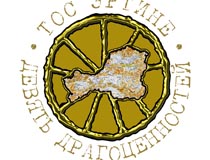|
 More than 120 noteworthy objects have already been entered into the “Nine Treasures” contest (Tos Ertine). The claims have been entered by schoolchildren, students, regional experts, as well as organizations. The greatest activity has been shown by district professional centers, which have been sending whole volumes with descriptions of the brightest noteworthy objects of the kozhuuns of Tuva. Today, the head of the Office of the chairman of the government, Artur Mongal, announced it in a direct broadcast on the TV channel “Tyva”. More than 120 noteworthy objects have already been entered into the “Nine Treasures” contest (Tos Ertine). The claims have been entered by schoolchildren, students, regional experts, as well as organizations. The greatest activity has been shown by district professional centers, which have been sending whole volumes with descriptions of the brightest noteworthy objects of the kozhuuns of Tuva. Today, the head of the Office of the chairman of the government, Artur Mongal, announced it in a direct broadcast on the TV channel “Tyva”. The start to the special project “Tos Ertine” was given by the head of Tuva, Sholban Kara-ool, on January 13 at the meeting with the journalists of the republic. “We live in a real pearl. But everything that surrounds us, we take, most often, for granted, - said the Premier. – only a look from the outside turns our attention to the fact that all around us are real treasures – natural, cultural, historical. You know that the number “nine” in our Tuvan mythology is a sacral number. Nine heavens, nine mountain passes, nine types of cattle, nine treasures. Our ancestors said that. Therefore, the name of the contest is “Nine Treasures”, and let’s collect them all together, bit by bit.” All the well-known noteworthy objects of the republic have been entered into the contest, including the obelisk “Center of Asia”, ancient fortress “Por-Bazhyn”, temple complex “Ustuu-Khuree”, lakes Azas, Sut-Khol, and Chagytai, where, as it is believed, the dust of legendary Genghis Khan is resting, the arzhaans – from Choigan of Todzha to Shivilig of Bai Taiga.
Artur Mongal turned attention to to the fact that the contest has uncovered little-known natural phenomena, which need scientific research, and that people speak of unique cultural and historical monuments, which are known to only a few local individuals.
“The main task is not as much to select the best, as to find everything that is interesting, original that is in our republic, to wake the people’s activity, their basic curiosity, the wish to search and to find miracles and wonders in one’s own native village, district, or city. After all, it is from this kind of inquisitive search and interest in history of one’s native country that love for it originates.” – emphasized the vice-premier.
Mongal noted that the deadline for the entries is on March 15. After that, the Expert Council will start its work. Among the members are: Mongush Borakhovich Kenin-Lopsan, doctor of historical sciences, researcher of shamanism, and owner of the title “Treasure of Shamanism”; Mongush Khurgul-oolovich Mannai-ool, legendary archeologist who took part in the excavations of the Arzhaan-1 kurgan; Kalin-ool Sereyevich Kuzhuget, candidate of geology-mineralogy sciences.
During the following stages of the contest, in the summer, entrepreneurs may make proposals about arrangements of various tourist object of their selection, noted the vice-premier, and we expect similar initiative from the populace or local administrations and work collectives. We already have the practice of the method of national construction of suburgans, work collectives – clean-up of the “Bobry” spring, why should we not arrange the noteworthy objects by the same method?
On April 1, the contest of journalist excellence also begins, which should produce broadened materials based on the entries. The entire summer period will be dedicated to the arrangement of the noteworthy objects and of their entire chain for tourist attractiveness. This again provides a lot of room for the journalists: to find those people, to show the active population which is trying to arrange these places, so that they could be included in the registry of the project. And the tour companies also have a lot of room for initiative: work-up of the many possible tourist itineraries that include the “treasures”.
We would like to encourage the understanding that this is not done just for the visitors to Tuva, but for ourselves as well. We need to bring back the former attitude to regional expertise, so that we would begin to discover Tuva for ourselves, and to travel around the republic. And also that suitable infrastructure would be built for this purpose, as Artur Mongal emphasized on the TV broadcast.
|
|
